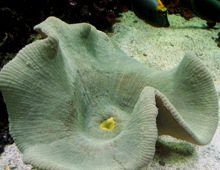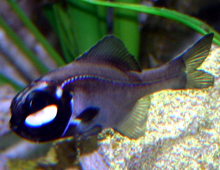Solomon Islands

Harlequin shrimp, Hymenocera picta
The colorful pattern of the Harlequin or Clown shrimp makes this beautiful crustacean quite popular. Its white or cream colored body is covered with distinctive red and purple spots. It has ten legs; the first pair are modified large, flattened claws (chelipeds). The eyes are located on stalks. The first pair of antennae on the head resemble a flattened leaf that sense the smell of nearby prey.
LEARN MORE
Carpet anemone, Stichodactyla mertensii
The Carpet anemone is named for its large size which resembles a carpet. The short tentacles have the appearance of the “pile” of a carpet, and have powerful stinging nematocysts. Many Carpet anemones serve as symbiotic hosts to clownfish who can hide within the anemone without being stung. Some Carpet anemones can grow to more than three feet in diameter.
LEARN MORE
White-capped clownfish, Amphiprion leucokranos
The White-capped clownfish is named for the white color mark on its forehead. The name “leucokranos” is derived from the Greek word meaning “white capped” or “white helmet”. It was discovered in 1972 in Mandang, New Guinea. As is the case in our Solomon Islands exhibit, the White capped clownfish is often associated with the Carpet anemone, Stichodactyla sp., and rarely strays far from the protection of its stinging tentacles. A thick mucous coating on its skin keeps the clownfish from being stung.
LEARN MORE
Blond naso tang, Naso elegans
Also known as the Elegant tang, or Indian orangespine unicornfish, the Blond naso is a member of the surgeonfish family. Two bright orange spines can be seen extending from the base of the tail. These spines are said to be “as sharp as a surgeon’s scalpel”, hence the name surgeonfish. This species was once thought to be a different color variety of the Lipstick tang, Naso lituratus, but is now considered its own species. The Blond naso is primarily a herbivore and can be found in coral reefs throughout the Indian Ocean and the Red Sea.
LEARN MORE
Leather coral, Sarcophyton spp.
Named for their appearance, which can resemble a baseball glove, the Leather coral, or Toadstool coral is found in various shades of brown, green, or yellow with white or gold polyps. It can be difficult to identify leather corals because many of them are similar in appearance. As they grow older, they develop a folded appearance. Like other soft corals, Leather corals incorporate tiny, single celled algae, known as zooxanthellae in their tissues.
LEARN MORE
Giant clams, Tridacna gigas
Tridacna gigas is the largest of the giant clam species, reaching more than 59 inches across in length and weighing more than 550 pounds. It is found on coral reefs throughout the Indo-Pacific, but may have become extinct in large parts of its former range. The adductor muscle of these clams is considered a delicacy in some areas, which has led to its overexploitation. Giant clams filter in microscopic plants and animals known as phytoplankton and zooplankton. Single celled phytoplankton, known as zooxanthellae, are photosynthetic and grow within the tissues of the clam providing it with nutrients and oxygen. For this reason, Giant clams are dependent upon light for survival.
LEARN MORE
Flashlightfish, Photoblepharon palpebratus
What may look like glowing eyes are actually organs beneath each eye that are inhabited by symbiotic bioluminescent bacteria. There are eight species of Flashlightfish found in warm seas around the world. Like their relatives, the Orange roughy and the squirrelfish, they are nocturnal animals that retreat to caves beneath reefs in the daytime, and hunt for small animals in shallower water at night.
LEARN MORE

